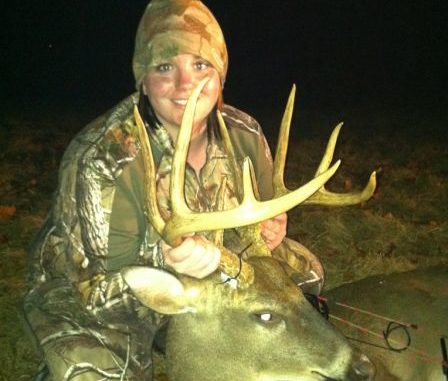
Remarkable resilience best describes Sherburne Wildlife Management Area, the huge tract of public acreage in the upper part of the Atchafalaya Basin that was subjected to both natural and man-made flooding in the spring and early summer of 2011.
If a Comeback WMA of the Year award was handed out it must go to the Sherburne WMA, which experienced slow flooding last spring before a decision to open the Morganza Spillway accelerated the rush of floodwaters that inundated the bottomland hardwoods area north and just south of Interstate 10 between Breaux Bridge and Grosse Tete.
One year and a few months later, WMA biologist supervisor Jonathan Bordelon said he believed Sherburne WMA offers the best opportunity to harvest a deer in 2012-13 among the WMAs he manages from his Opelousas-based office. And the list includes such storied public lands as Red River/Three Rivers WMAs, Spring River WMA, Grassy Lake WMA and Thistlethwaite WMA.
“There’s no reason we won’t be one of the more-productive areas in our region,” Bordelon said. “All of the data complements our assumptions that the deer herd was able to cope with the impacts from the 2011 flood.
“Knowing the deer herd weathered the storm, I’m anticipating a great season this year.”
Why? Because last season, despite a drastically shortened deer hunting season on the Sherburne WMA, deer hunters killed as many deer per hunter effort as they did in 2010-11, when 534 deer were killed.
Two hundred twenty-one deer were reported harvested per 199 acres last season.
Want more proof? Lottery youth hunters reported they observed twice as many deer as the previous season (201 to 99) on Sherburne WMA and, more importantly, 11 of 30 lottery youth hunters killed a deer — up three over 2010-11.
Bottom line? An overwhelming majority of deer apparently survived all the water over terra firma.
Also, squirrel-hunting success was above average (929 harvested) and, pleasantly surprising, rabbit hunting (101 rabbits harvested) on Sherburne WMA ranked right up there with Spring Bayou WMA (116 harvested) and the Red River/Three Rivers complex (110 harvested).
“With Sherburne, last year we were real cautious” when it came to scheduling the deer hunting season, Bordelon said, noting that without concrete data on the flood’s impact he decided to err on the side of caution and dialed up a short, restrictive hunting season for deer.
“A more-conservative season was implemented due to concerns from flood-related mortality,” he said. “Now that more data are available, we are comfortable adding days back to provide more opportunity for hunting during the upcoming season.”
Bordelon and other biologists pretty much anticipated the encouraging outcome following one of the worst modern-day floods in Southcentral Louisiana.
This is what he and other dedicated biologists found, notably some direct mortality on the northern part of the area with other deer escaping to higher ground adjacent to the Sherburne WMA.
“LDWF biological staff covered 70 miles of transects on Sherburne WMA the first couple of weeks after the flood water inundated the WMA,” Bordelon said. “Transects were run to document site conditions, wildlife losses and wildlife sightings.
“Seventeen deer were discovered over the 70 miles of transect covered. However, large groups and numbers of live deer were observed on higher ground adjacent to the floodwater. Many of the deer on the southern portion of the WMA were forced out by slow-rising backwater. This benefited these animals since they were then out of the path of fast-rising waters from the spillway opening.
“Also, this was somewhat apparent off of the WMA when transects were run both north and south of the WMA. No deer mortality was detected on transect surveys south of I-10. However, five deer were observed dead north of (U.S.) 190 on 27 miles of transect.”
Bordelon said those deaths shouldn’t be of huge concern.
“While these losses may alarm some, the vast majority (of deer) did survive and returned back to the area once floodwaters receded,” he said. “This was supported by browse surveys conducted by biological staff two months after post-flood green up.
“Browse utilization was near the same levels recorded during a spring browse survey conducted” about the same time the year before.
Most deer hunters who stuck to the area last season were optimistic, and they were rewarded, he said.
It wasn’t all roses after the flood of 2011, however; some wildlife were unable to flee the advancing floodwater as easily as others — namely turkeys and rabbits.
“It was mostly about animals other than deer,” Bordelon said. “It (water level) shot up really quickly. They weren’t able to cope with it as much as a slow rise.”
Turkeys were hit particularly hard.
“That species suffered greatly,” he said. “The biggest negative was to turkey. The flood wiped out a whole year’s worth of production. They’ll bounce back, definitely. But this past turkey season young birds were absent in the harvest, and next year they won’t have a 2-year-old crop in there.”
Rabbits, Bordelon said, also were impacted; there was stress and some mortality, he said.
But as prolific as rabbits are, he said they should recover because after this spring’s green up there were beau coup groceries for them.
And Bordelon saw firsthand just how determined rabbits were while doing transects: Many survived by climbing onto floating debris and anything staying above the water — even tree branches.


